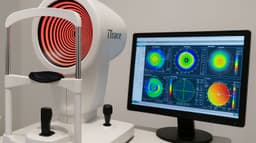
Can LASIK Fix Bad Vision?
LASIK, short for Laser-Assisted In Situ Keratomileusis, stands as a hope for individuals seeking freedom from the shackles of corrective eyewear. This revolutionary surgical procedure has transformed the landscape of vision correction, offering a newfound clarity to millions worldwide. Through precise and innovative technology, LASIK has not only corrected refractive errors but has also redefined the way people perceive the world around them. Its profound impact on the lives of countless individuals is a testament to the power of science in enhancing our most fundamental sense - the gift of sight.
Can LASIK Eye Surgery Fix Poor Eye Sight?
LASIK is highly effective in correcting a range of refractive errors, including nearsightedness (myopia), farsightedness (hyperopia), and astigmatism. However, its effectiveness may vary depending on the severity of the refractive error.
In general, LASIK is most successful in treating mild to moderate refractive errors. If a person has extremely high levels of nearsightedness, farsightedness, or astigmatism, the procedure may not fully correct their vision to 20/20 without needing glasses or contact lenses.
In such cases, a consultation with an ophthalmologist or LASIK surgeon is crucial. They will be able to assess the individual's specific situation and advise on the suitability of LASIK or recommend alternative options, such as implantable collamer lenses (ICLs) or other advanced surgical techniques.
Advancements in LASIK technology and surgical techniques continue to expand the range of treatable refractive errors, so what may have been considered "really bad vision" in the past may now be within the scope of LASIK treatment. Consulting with a qualified eye care professional is the best way to determine the most appropriate course of action for individual cases.

When Is LASIK Not Suitable For Eye Surgery?
LASIK may not be suitable for certain individuals or under specific circumstances. Here are some situations in which LASIK may not be recommended:
Age and Stability of Prescription
LASIK is typically not recommended for individuals under 18 years old, as their eyes may still be developing. Additionally, for adults, their prescription must stabilise for at least 1 year before considering LASIK.
Pregnancy and Breastfeeding
Hormonal changes during pregnancy and breastfeeding can affect vision, so it's generally advised to wait until hormonal levels stabilise before undergoing LASIK.
Unstable Refractive Errors
If a person's prescription is still changing, LASIK may not be the best option. This is because the procedure reshapes the cornea to correct a specific prescription, and if the prescription changes after the surgery, it can lead to suboptimal results.
Thin Corneas
LASIK involves creating a flap on the cornea before reshaping it. If a person has thin corneas, there may not be enough tissue to safely create this flap.
Corneal Diseases or Conditions
Certain corneal conditions, such as keratoconus, may disqualify a person from LASIK. Additionally, severe dry eye syndrome or other ocular surface disorders can be contraindications.
Cataracts or Other Eye Conditions
LASIK is designed to correct refractive errors, not treat other eye conditions like cataracts. In such cases, a different surgical procedure may be more appropriate.
Autoimmune Disorders and Medications
Conditions or medications that affect the body's ability to heal properly may make LASIK less suitable.
Eye Health and Overall Health Issues
Individuals with a history of certain eye diseases or significant general health problems may not be good candidates for LASIK.
Unrealistic Expectations
Some individuals may have expectations that LASIK cannot realistically meet. It's important to have a clear understanding of what LASIK can and cannot achieve.
It's crucial for individuals considering LASIK to have a thorough consultation with an experienced ophthalmologist or LASIK surgeon. They will conduct a comprehensive evaluation to determine whether LASIK is a suitable option based on the individual's specific eye health, medical history, and lifestyle. If LASIK is not recommended, alternative vision correction options can be discussed.
What Is The Technology Behind LASIK?
LASIK, or Laser-Assisted In Situ Keratomileusis, is a surgical procedure that utilises advanced laser technology to reshape the cornea, which is the clear front surface of the eye. This reshaping corrects refractive errors such as nearsightedness (myopia), farsightedness (hyperopia), and astigmatism.
Here's a step-by-step explanation of the technology behind LASIK:
Pre-operative Evaluation
- Before the LASIK procedure, the patient undergoes a comprehensive eye examination. This includes measurements of the corneal thickness, pupil size, and the shape of the cornea.
- Advanced diagnostic tools like corneal topography and wavefront analysis are often used to create a detailed map of the eye's surface and identify specific irregularities.
Creating the Flap
- In traditional LASIK, a femtosecond laser is used to create a thin, circular flap on the cornea.
- Femtosecond laser uses ultra-fast laser pulses to create a precise, customised flap. This step is crucial in maintaining the integrity of the cornea during the procedure.
Laser Reshaping of the Cornea
- With the corneal flap gently lifted, an excimer laser is used to reshape the underlying corneal tissue. The excimer laser emits a beam of ultraviolet light, which is precisely focused and doesn't produce heat.
- The laser ablates (removes) microscopic layers of tissue from the cornea based on the personalised treatment plan determined during the pre-operative evaluation. This reshaping allows light to be properly focused on the retina.
Real-time Tracking and Guided Treatments
- During the laser ablation process, advanced eye-tracking technology is employed to monitor and adjust for any tiny eye movements. This ensures the accuracy of the treatment and helps achieve the desired outcome.
Flap Replacement
- After the laser treatment, the corneal flap is carefully repositioned. It adheres naturally without the need for stitches.
Post-operative Care and Recovery
- Following the procedure, patients are advised to rest and take prescribed medications to aid in the healing process. Protective shields may be provided to prevent accidental contact with the eyes.
Follow-up Examinations
- Patients undergo post-operative examinations to monitor the healing progress and ensure that the desired visual correction has been achieved.
The key technological components of LASIK include the excimer laser for precise corneal reshaping, advanced diagnostic tools for pre-operative evaluation, and eye-tracking systems to enhance accuracy during the procedure. The choice of creating the corneal flap with a microkeratome or femtosecond laser represents a crucial technological advancement that enhances the safety and precision of the procedure.
Overall, LASIK technology has significantly evolved over the years, leading to high success rates and improved outcomes for millions of individuals seeking freedom from glasses and contact lenses.
Find out more by Speaking to our team









